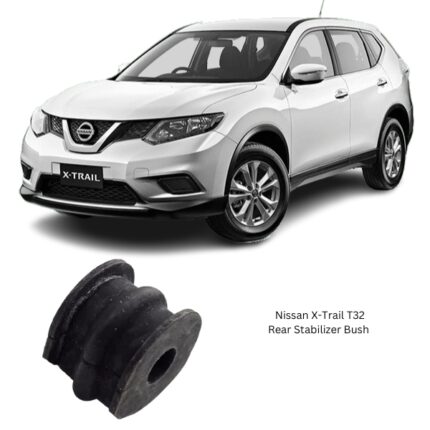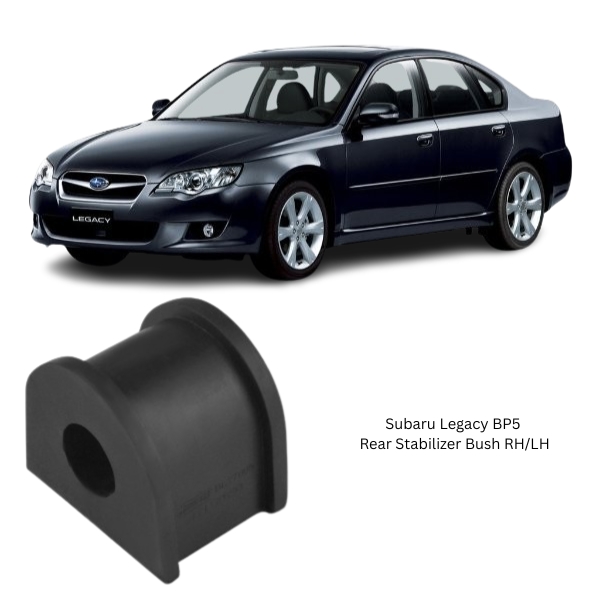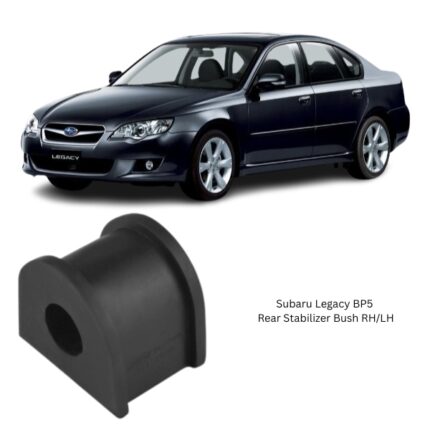Get Subaru Legacy BP5 Rear Stabilizer Bush RH/LH 20464-AE020 in Kenya
The rear stabilizer bush (Right Hand/Left Hand) is a crucial suspension component that provides stability, comfort, and control in the rear end of a vehicle. It is specifically designed to secure and cushion the rear stabilizer bar—also known as the anti-roll bar or sway bar—preventing excessive lateral movement while allowing controlled flexibility. Though compact, the rear stabilizer bush plays an integral role in ensuring balanced handling, particularly during cornering, braking, and driving over uneven terrain.
This description provides an in-depth analysis of the rear stabilizer bush, including its function, construction, symptoms of wear, installation considerations, and its significance in the overall suspension system.
1. Purpose and Function of Rear Stabilizer Bush (RH/LH)
The rear stabilizer bush is positioned on both the right-hand (RH) and left-hand (LH) sides of the rear suspension. It wraps around the rear stabilizer bar and mounts to the chassis or rear subframe, allowing the bar to twist as the vehicle encounters road irregularities. The bush acts as both a cushion and guide, enabling controlled articulation of the stabilizer bar while isolating it from the vehicle body.
The stabilizer bar itself connects the left and right suspension arms. During turns or uneven road contact, the bar resists body roll by transferring force from one side to the other. The bush ensures the bar remains firmly positioned and rotates smoothly under load.
Key functions include:
-
Holding the stabilizer bar securely in place.
-
Allowing controlled twisting motion of the bar.
-
Absorbing road shocks and vibrations.
-
Preventing direct metal-to-metal contact.
-
Reducing noise and wear.
2. Placement and Mounting
The rear stabilizer bushes are located at fixed points where the stabilizer bar is mounted to the vehicle frame. One bush is installed on the right-hand side, and the other on the left-hand side—hence the RH/LH designation. These bushes are usually clamped to the bar via metal brackets, which are bolted directly to the rear subframe.
Depending on the vehicle model, the rear stabilizer bushes may be accessible from beneath the car without removing major components, though some designs may require additional disassembly.
3. Design and Structure
Most rear stabilizer bushes are semi-cylindrical or cylindrical in shape, with the following key characteristics:
-
Split Opening: Allows for easy installation around the stabilizer bar.
-
Inner Bore: Precision-molded to match the diameter of the bar for snug fitment.
-
Grooved Surface: Some designs include inner grooves for lubrication retention and reduced friction.
-
Bracket Compatibility: Designed to fit inside specific brackets or clamps for secure attachment.
The bush allows the bar to rotate slightly within its housing during suspension articulation, but without excessive play. This controlled movement enables effective energy transfer while reducing wear and noise.
4. Material Composition
Rear stabilizer bushes are typically made from materials engineered for flexibility, durability, and resistance to environmental stress:
a) Natural Rubber
-
Common in standard passenger vehicles.
-
Excellent vibration absorption.
-
Cost-effective and offers good flexibility.
b) Polyurethane (PU)
-
Popular in performance or heavy-duty applications.
-
Stiffer than rubber, providing improved responsiveness.
-
Resistant to oil, fuel, ozone, and UV degradation.
-
Longer service life, but may transmit slightly more road vibration.
c) Synthetic Elastomers
-
Offer a blend of durability and softness.
-
Often used in modern vehicle designs for balanced comfort and performance.
Material choice impacts performance, ride comfort, and longevity, so it’s critical to select a bush type that suits the vehicle’s intended use and driving conditions.
5. Working Principle with the Suspension System
When the vehicle turns or travels over an uneven surface, the rear stabilizer bar twists to compensate for the unequal movement of the rear wheels. The RH and LH stabilizer bushes anchor the bar at two fixed points and allow it to pivot while absorbing lateral force.
For example:
-
During a sharp right turn, the vehicle body leans left due to inertia. The left rear suspension compresses, and the right rear extends.
-
The stabilizer bar twists to counter this motion, helping to keep the vehicle level.
-
The bushes permit this motion while preventing the bar from shifting or banging against the frame.
Without the stabilizer bushes, the bar would have uncontrolled movement, leading to noise, inefficient energy transfer, and eventual component damage.
6. Symptoms of Worn Rear Stabilizer Bushes
Over time, rear stabilizer bushes degrade due to heat, moisture, road salt, chemicals, and physical stress. Common symptoms of failure include:
a) Clunking or Knocking Noise
-
Audible when driving over bumps or during turns.
-
Caused by excessive play or looseness between the stabilizer bar and bush.
b) Poor Rear-End Stability
-
Increased body roll or sway, especially during cornering.
-
Reduced control and responsiveness in handling.
c) Uneven Tire Wear
-
May result from destabilized suspension geometry.
d) Visual Damage
-
Cracks, deformation, hardening, or excessive wear on the bush surface.
-
Gaps between the bush and stabilizer bar or frame mount.
Timely diagnosis and replacement prevent further suspension damage and maintain safety.
7. Inspection and Diagnosis
To check for worn rear stabilizer bushes:
-
Visual Inspection: Look for visible cracks, tears, or rubber deterioration.
-
Pry Bar Test: Use a pry tool to move the stabilizer bar; excessive movement within the bush indicates wear.
-
Test Drive: Listen for noise and observe handling characteristics while cornering or going over bumps.
A thorough inspection should be part of routine suspension maintenance, especially if the vehicle is used in rough conditions.
8. Replacement Procedure
Replacing rear stabilizer bushes is typically a straightforward process:
-
Raise and Support Vehicle: Secure the rear of the vehicle on jack stands.
-
Locate the Bushes: Identify the RH and LH stabilizer bushes along the stabilizer bar.
-
Unbolt the Brackets: Loosen and remove the bolts holding the bush brackets.
-
Remove Old Bushes: Slide or pry off the old bush from the stabilizer bar.
-
Install New Bushes: Wrap the new bush around the bar, ensuring proper orientation.
-
Reinstall Brackets: Secure the clamps over the new bush and torque bolts to specification.
Replacement in pairs (both RH and LH) is highly recommended for even performance and safety.
9. Maintenance and Longevity
To ensure a long-lasting and effective stabilizer system:
-
Use Correct Replacement Material: Choose rubber or polyurethane based on vehicle application.
-
Avoid Harsh Chemicals: Clean the undercarriage with appropriate degreasers to prevent rubber degradation.
-
Inspect Regularly: Check during oil changes or suspension work.
-
Keep Suspension Components Aligned: Misaligned parts accelerate wear on the stabilizer system.
High-quality rubber bushes can last 60,000 to 100,000 kilometers, while polyurethane options may exceed this with proper care.
10. Importance in Ride Quality and Safety
The rear stabilizer bushes contribute significantly to the following:
-
Vehicle Balance: Helps maintain level posture during turns.
-
Cornering Control: Reduces lean and enhances road grip.
-
Cabin Comfort: Dampens suspension noise and vibrations.
-
Component Protection: Minimizes wear on the stabilizer bar, suspension arms, and other linkage parts.
-
Driving Confidence: Provides predictable handling, especially under load or at speed.
They are particularly important in SUVs, trucks, and vehicles with high centers of gravity, where roll resistance is critical.
Follow us on Facebook for more parts.





Reviews
Clear filtersThere are no reviews yet.